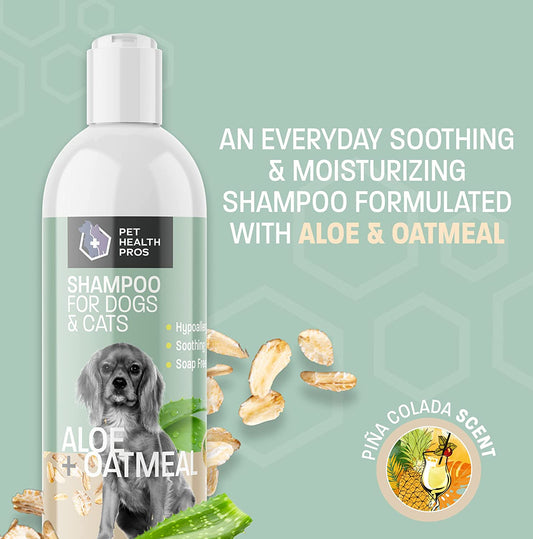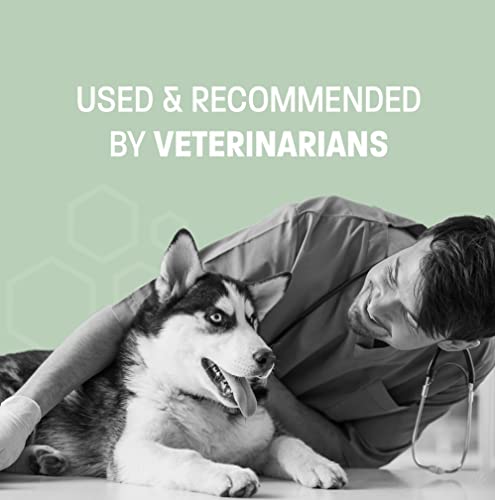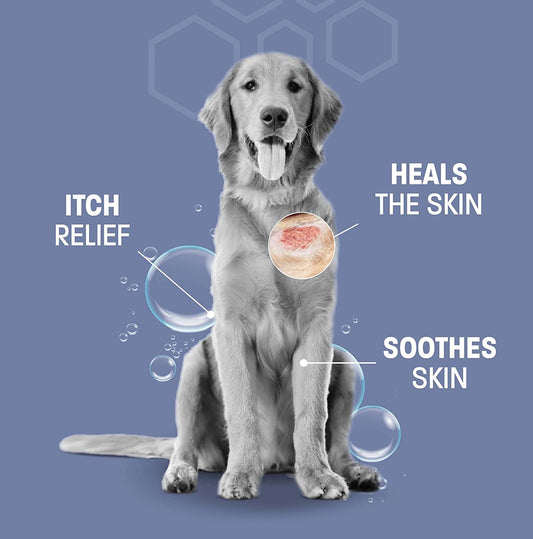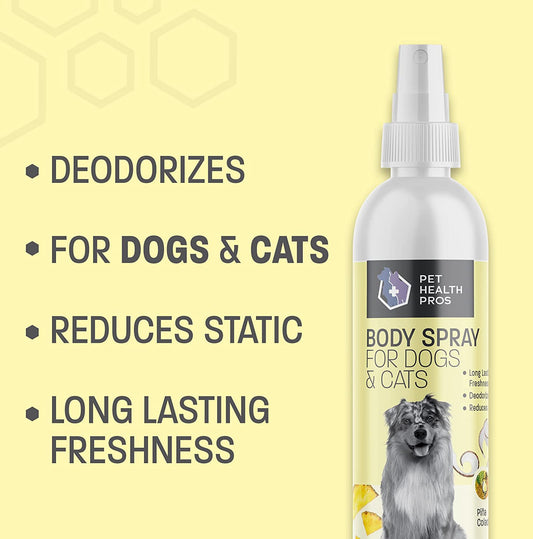Hot spots can be a real pain for dogs, causing them discomfort and stress. These irritated patches of skin can appear suddenly and can be tricky to treat. Using a hot spot spray can help soothe your dog's skin and speed up the healing process. In this article, we'll walk you through everything you need to know about using hot spot sprays effectively, from choosing the right product to applying it correctly and preventing future outbreaks.
Key Takeaways
- Hot spots are irritated patches of skin that can cause discomfort for dogs.
- Choosing a hot spot spray with natural ingredients can help avoid harmful side effects.
- Proper application of the spray is crucial for effective treatment.
- Maintaining your dog's hygiene and diet can help prevent future hot spots.
- Consulting a vet is important if the hot spots persist or worsen.
Understanding Hot Spots in Dogs
What Are Hot Spots?
Hot spots, also known as acute moist dermatitis, are inflamed and infected areas on a dog's skin. These spots can appear suddenly and grow rapidly, causing significant discomfort for your pet. Hot spots are typically red, moist, and may ooze pus. They are often found on the head, hips, and legs of dogs.
Common Causes of Hot Spots
Hot spots can be triggered by various factors, including:
- Allergies: Dogs can experience allergies from various sources, leading to symptoms like itchy skin and rashes.
- Flea bites
- Poor grooming
- Underlying skin infections
- Excessive licking or chewing due to boredom or stress
Symptoms to Watch For
It's important to recognize the symptoms of hot spots early to prevent them from worsening. Look out for:
- Red, inflamed skin
- Constant scratching or licking of a particular area
- Hair loss around the affected spot
- Foul odor from the infected area
If you notice any of these symptoms, it's crucial to take action quickly to provide relief for your dog and prevent further complications.
Choosing the Right Hot Spot Spray for Dogs
Ingredients to Look For
When selecting a hot spot spray for your dog, it's important to check the ingredients. Look for natural ingredients like aloe vera, chamomile, and tea tree oil. These can help soothe your dog's skin and promote healing. Avoid sprays with alcohol, as it can dry out the skin and cause more irritation.
Avoiding Harmful Chemicals
Many sprays contain chemicals that can be harmful to your dog. Stay away from products with artificial fragrances, dyes, and parabens. These can cause allergic reactions and worsen the hot spots. Always read the label carefully to ensure the product is safe for your pet.
Recommended Brands
There are several reputable brands that offer effective hot spot sprays. Pet Health Pros is one such brand known for its quality products. They offer a range of sprays that are free from harmful chemicals and contain soothing ingredients. Other recommended brands include Vet's Best and Burt's Bees, which are also known for their natural and safe formulations.
Choosing the right hot spot spray can make a big difference in your dog's comfort and recovery. Always opt for products with natural ingredients and avoid harmful chemicals to ensure the best care for your furry friend.
How to Apply Hot Spot Spray Effectively
Preparing Your Dog for Treatment
Before you start, make sure your dog is calm and comfortable. You might want to give them a treat or a toy to keep them occupied. Gently clean the affected area with a mild soap and water, then pat it dry with a clean towel. This helps remove any dirt or debris that could interfere with the spray.
Step-by-Step Application Guide
- Shake the hot spot spray bottle well before use.
- Hold the bottle a few inches away from the affected area.
- Spray directly on the raw, irritated hot spots. Repeat 1-4 times daily as needed.
- If your dog suffers from flea allergies, spray the entire body daily or as needed.
- Allow the spray to dry naturally; do not wipe it off.
Post-Application Care
After applying the spray, keep an eye on your dog to make sure they don't lick or scratch the treated area. You might need to use an e-collar to prevent this. Monitor the area for signs of improvement, such as reduced redness and less itching. If you don't see any improvement within a few days, consult your vet for further advice.
Proper application of hot spot spray can make a big difference in your dog's comfort and healing process.
Preventing Hot Spots in Dogs
Maintaining Proper Hygiene
Keeping your dog clean is essential to prevent hot spots. Regular baths and grooming help remove dirt and bacteria that can cause skin issues. Brushing your dog's coat daily can also help distribute natural oils and remove dead hair, reducing the risk of hot spots.
Diet and Nutrition Tips
A balanced diet is crucial for your dog's skin health. Ensure your dog gets the right nutrients, including omega-3 fatty acids, which are known to improve skin condition. Avoid feeding your dog low-quality food that can lead to skin problems.
Regular Vet Check-Ups
Frequent visits to the vet can help catch skin issues early before they become severe. Your vet can provide advice on the best ways to keep your dog's skin healthy and recommend treatments if needed. Depending on the hot spot's severity, most veterinarians will treat the area with a combination of oral antibiotics, anti-itch medication, and a recovery cone.
Prevention is always better than cure. By maintaining proper hygiene, providing a balanced diet, and scheduling regular vet check-ups, you can significantly reduce the risk of hot spots in your dog.
Alternative Treatments for Hot Spots
Natural Remedies
Natural remedies can be a gentle way to treat hot spots on your dog. Aloe vera is known for its soothing properties and can help reduce inflammation. Coconut oil is another option, as it has antibacterial and antifungal properties. Simply apply a small amount to the affected area. Additionally, chamomile tea can be used as a rinse to calm irritated skin.
Over-the-Counter Options
There are several over-the-counter treatments available for hot spots. Hydrocortisone creams can help reduce itching and inflammation. Antibacterial sprays and wipes are also effective in keeping the area clean and preventing infection. Always read the labels to ensure the product is safe for dogs.
When to See a Vet
If your dog's hot spot does not improve with home treatment, it is important to consult a vet. Persistent or severe hot spots may require prescription medication or other professional treatments. Ignoring severe symptoms can lead to more serious health issues.
It's crucial to monitor your dog's condition and seek professional help if needed. Early intervention can prevent complications and promote faster healing.
Understanding the Benefits of Hot Spot Spray
Immediate Relief for Your Dog
Hot spot sprays are designed to provide immediate relief for your dog's irritated skin. The no-sting formula ensures that your dog feels comfortable during application. This is especially important for red, raw, or inflamed skin, as it helps to soothe the area quickly.
Promoting Healing
Using a hot spot spray can significantly speed up the healing process. These sprays often contain ingredients that not only relieve itching but also promote skin repair. This dual action helps your dog recover faster and reduces the chances of the hot spot worsening.
Preventing Recurrence
Regular use of hot spot spray can help in preventing the recurrence of hot spots. By keeping the skin clean and moisturized, these sprays create an environment that is less conducive to the development of new hot spots. This is crucial for dogs that are prone to skin issues.
Consistent use of hot spot spray can make a noticeable difference in your dog's skin health, providing both immediate and long-term benefits.
Common Mistakes to Avoid When Using Hot Spot Spray
Overusing the Spray
One common mistake is applying the hot spot spray too frequently. Overuse can irritate your dog's skin and may even worsen the hot spot. Always follow the instructions on the product label for the correct frequency of application.
Ignoring Underlying Issues
Hot spots often have underlying causes such as allergies, parasites, or infections. Simply using a spray without addressing these root problems can lead to recurring issues. It's essential to identify and treat the underlying cause to ensure long-term relief for your dog.
Not Following Instructions
Each hot spot spray comes with specific instructions for use. Not following these guidelines can reduce the effectiveness of the treatment. Make sure to read and adhere to the instructions carefully to get the best results.
Proper use of hot spot spray involves understanding the product and your dog's specific needs. Always consult your vet if you're unsure about the treatment plan.
Using hot spot spray incorrectly can make your pet's skin problems worse. Always follow the instructions on the label and avoid overusing the product. For more tips on keeping your pet healthy, visit our website.
Conclusion
Using hot spot spray for dogs can be a simple and effective way to help your furry friend feel better. By following the tips and tricks we've shared, you can make sure you're using the spray correctly and safely. Always remember to read the instructions on the bottle and consult your vet if you have any questions. With the right care, your dog can be on the road to recovery in no time. Keep an eye on your pet's skin and be proactive in treating any issues that come up. Your dog will thank you for it!
Frequently Asked Questions
What are hot spots on dogs?
Hot spots are red, inflamed areas on a dog's skin that can be very itchy and painful. They are often caused by allergies, insect bites, or excessive licking.
How do I choose the right hot spot spray for my dog?
Look for sprays with natural ingredients like aloe vera and chamomile. Avoid products with alcohol or artificial fragrances, as they can irritate your dog's skin.
How often should I apply hot spot spray?
You should follow the instructions on the product label. Generally, you can apply the spray 2-3 times a day until the hot spot starts to heal.
Can I use hot spot spray on puppies?
It's best to consult your vet before using any medication on puppies. Some sprays may be too strong for young dogs.
What should I do if my dog's hot spot doesn't improve?
If the hot spot doesn't get better after a few days of treatment, or if it gets worse, you should take your dog to the vet. There could be an underlying issue that needs professional care.
Are there any side effects of using hot spot spray?
Most hot spot sprays are safe, but some dogs might have a mild reaction like redness or itching. If you notice any severe reactions, stop using the spray and consult your vet.









